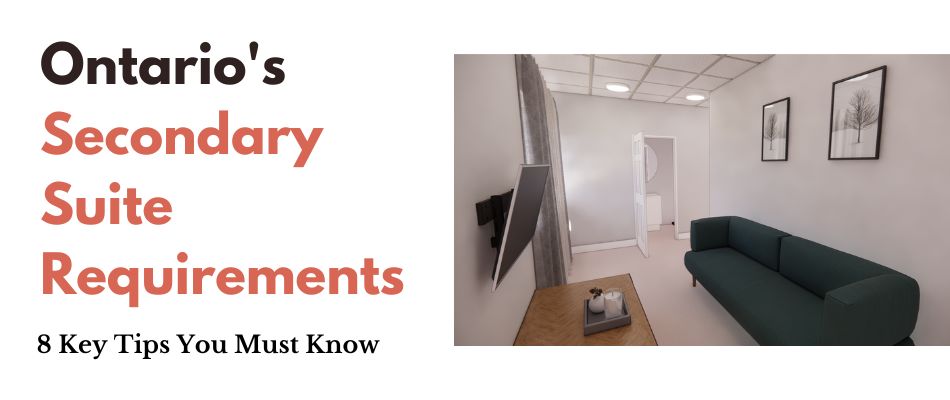This article will discuss every critical secondary suite requirement in Ontario. The newest Housing Supply Action Plan, More Homes Built Faster, says you can add up to three extra residential units on a single lot. Hence, you have more opportunities to develop multiplexes. As a homeowner and real estate investor, these opportunities can enhance rental income and property value.
Accordingly, you may no longer pay development charges and parkland dedication fees on the units.
Hence, it makes sense to make the best plan for your secondary unit according to your goals and budget. You must also ensure that your secondary unit meets local regulations and standards. Here are 8 crucial tips to walk you through the secondary suite installation process.
Secondary Suite Requirements and Housing Policy Changes
The new housing policy states that you can have up to three units. These units can be created within your existing residential unit or as a residence. This can be in the form of an in-law or basement suite and a laneway or garden home.
So, you now have more flexibility with these additional units. Still, the Ontario Building Code (OBC) is just as important. The OBC outlines minimum health and safety standards. You need to familiarize yourself with the OBC before starting construction. For example, all common areas, staircases, and living spaces must have a minimum headroom clearance of 6 feet 5 inches.
Also, consider fire separation, safe exits, and plumbing specifications, and community regulations. Are you considering duplex or triplex conversions? Get a qualified BCIN designer to ensure your plans meet all safety stipulations.
Determine What Type of Properties are Best for Conversions
Choosing your property type for conversion is ideal to maximize your investment returns. That said, different property types have benefits and drawbacks. These advantages and disadvantages will help maximize your duplex, triplex, or fourplex conversions.
Bungalow and Bungaloft for Duplex Conversion
Bungalows and bungalofts can be excellent choices for duplex conversions for several reasons:
- Space Management: Bungalows offer more horizontal space. So you can divide it into two separate units. Bungalofts, with their loft spaces, also offer square footage. This means your smaller unit may also have extra space.
- Layout Flexibility: These buildings have single-storey layouts (plus the additional loft space in a bungaloft). Hence, you don’t need extensive architectural modifications. This makes the conversion process more straightforward and less costly.
- Separate Entrances: Many bungalows (and bungalofts) have existing secondary entrances into the basement. This is a needed feature for creating independent units in a duplex conversion.
- Attractiveness to Tenants: Bungalows and bungalofts often have an appealing charm factor. This can help attract quality tenants. The extra loft space in a bungaloft can also serve as a selling point for potential renters.
Two Storey and 2 ½ Storey House for Triplex or Fourplex Conversion
Two-storey and 2 ½-storey houses are often considered ideal for triplex or fourplex conversions due to the following advantages:
- Multiple Floors for Individual Units: The vertical space available in a two-storey and 2 ½-storey house allows for the creation of numerous independent units stacked one above the other, thus maximizing the potential rental income.
- Cost-Effective Construction: Converting an existing two storey or 2 ½ storey house into a triplex or fourplex is often more cost-effective than constructing a new building from scratch. Utilizing the existing framework, foundation, and infrastructure significantly reduces construction costs and time, making it an attractive option for developers looking to optimize their investment.
- Ease of Conversion: You don’t have to modify the existing structure of a two or 2 1/2-storey house so much. If you plan and design correctly, you can efficiently convert, reducing the cost of major structural changes.
- Appeal to Various Tenant Demographics: By transforming the property into smaller, independent units, you can attract a broader range of potential tenants, such as singles, couples, and small families.
These benefits will help you select the right property type and make prudent decisions. Hence, you can enjoy substantial financial benefits and provide more quality housing for the local community.
Zoning By-laws and Secondary Suite Requirements
Following the More Homes Built Faster, many restrictions surrounding secondary suites disappeared. But you should always double-check what applies to your specific area. For instance, Toronto City Council, on May 10, 2023, made amendments to zoning by-laws. So, yes, they have simplified zoning and approval processes and reduced financial barriers. Check how the zoning by-laws for your particular neighbourhood influence design for multiplex houses (duplexes) and multiples buildings (triplexes, fourplexes).
To determine what zoning laws say about your property, you can check out your local city websites. These websites provide/ zoning maps and by-law information for neighbourhoods and individual properties. You can also contact your local planning department for guidance.
Take Advantage of Secondary Suite Programs
Many provinces across Canada have at least one program that helps ease the cost of building a secondary suite. Ontario isn’t left out. You’ll find multiple programs aimed at creating and improving secondary suites. But do note that these programs often have limits on how much the secondary suite can be rented when renovated. These programs also offer a grant of up to $25,000 with these programs. Some municipalities in Ontario offering some secondary unit programs include:
- Hamilton
- Peel renovates second units
- Barrie and many more.
Additionally, you can look up energy efficiency and green building incentive programs in your area. These programs offset some of the costs of constructing a secondary, garden, or garage suite.
Creating a Quality Unit
Not all secondary suite approvals meet municipality laws. This is due to their unit’s structure and inability to get permits for the work done. However, you should focus on the following areas to provide comfort, safety, and overall appeal of the secondary suite.
Adding soundproofing
Soundproofing aids to ensure the privacy of the occupants and minimize disturbances between different units. You can add soundproofing using acoustic insulation within wall cavities or opt for specialized drywall. Floor underlayments are also great for reducing sound transfer.
Heating and cooling consideration
One of the secondary suite requirements you should pay attention to is heating and calling. You may need an independent HVAC system for your secondary suite. Insulation is equally important to maintain temperature and reduce energy consumption.
Allowing natural light
You need to consider window placement to allow for natural light carefully. Consider larger windows or glass doors that enhance natural light availability.
Creating a Safe Unit
Creating a safe unit is one of the non-negotiable secondary suite requirements. These principles ensure dwellings can guarantee the well-being and safety of occupants. Fortunately, the OBC and local regulations have clear instructions regarding egress, fire separation, and smoke alarms.
Egress requirements
Egress refers to means of exiting the property in the case of emergency. So naturally, you need doors, and windows. The minimum unobstructed open portion of the window should be at least 0.35 square metres ( 3.77 square feet) with no dimension less than 380 mm (15 inches). Every suite must also have at least one door providing access to the doorway leading to the exterior.
Fire separation requirements
Individual unit ceilings and walls that separate common spaces must have a minimum fire resistance rating 30 mins to 1hour. All doors are assembled with the fire separation barrier and must have at least a 20-minute fire protection rating and be equipped with a closer. All joints, penetration (e.g., by pipes, ducts, cables), and openings in the fire separation must be sealed with an appropriate fire stop system.
Smoke alarm requirements
Smoke alarms enable you to detect fire as early as possible. So, you need to position them on every story and outside every sleeping area. For additional safety, consider installing inside bedrooms and common areas as well. All smoke alarms should also be interconnected to sound together once any one of them is activated.
Fire Escapes
Every unit must have a separate exit to the outside, and if not it will require a secondary means of egress. when converting existing homes, this is challenging to be achieved. So, different rules depend on location, and the number of fire escapes possible. Here are the rules of thumb for different situations:
- Suppose the secondary suite has a common exit with a 30-minute fire separation and contains a smoke alarm that is interconnected to both units. In that case, it can be used as the primary fire escape.
- For basement and above-grade apartments with a direct exit or below grade walk-out, that is the only requirement for the secondary suite.
- For basement and above-graded apartments with no dedicated exterior walk-out or common exit, you need a secondary form of egress through an egress window.
Keep the Future in Mind
It’s important to not focus on immediate needs. Anticipate the future users or requirements of the space. Make considerations like mobility changes and aging in place. Also, consider that potential tenants may have specific needs to guide your design choices for longevity. Here are some ideas to consider:
Wider door frames
Wider door frames can accommodate wheelchair users or those who use other assistive walking devices.
Main floor suite location
Consider locating the secondary unit on the main level to help occupants avoid climbing stairs. This is especially important if your intended tenants are aging people. A primary floor location also dramatically enhances the usability and accessibility of the space.
Accessible bathrooms
Consider barrier-free shows, installing grab bars, higher toilets, and lever faucets. These elements help create bathrooms that are usable by all people regardless of size, age, or ability.
Handling Utility Considerations
One of the other secondary suite requirements you must consider is how your utilities perform. It’s vital to consider your electrical, HVAC, and plumbing systems carefully.
Electrical amperage
The electric amperage capacity needed will vary depending on whether you convert to duplex, triplex, or fourplex. For example a 100amp service can serve a duplex provided the the range or laundry appliance is gas fuelled, while a triplex or fourplex may require up to 200amp or even a 400amp service depending on the whether gas is also used as a fuelling source. However, you must consult a licensed electrician to perform load calculations and modify your panel accordingly.
HVAC separations
As said earlier, consider independent heating and cooling systems for each unit. This allows occupants to control their temperatures and simplify billing. Shared systems may also be used, but you must plan correctly to ensure balanced and comfortable conditioning of each unit.
Plumbing metering operations
Managing water use across a multi-unit property also poses some challenges regarding billing. Individually metered units give the most accurate readings but can be expensive as they are separate. A single metre for the entire building with costs allocated based on unit size is more affordable. However, it can cause disagreements if one tenant uses more water than others.
Conclusion
The potential benefits of installing secondary suites in Ontario are plenty. All you need do is adhere to the legal and building regulations. Stay current on the secondary suite requirements and how local zoning by-laws impact them. By doing so, you contribute positively to your community through more housing options and creating an income stream.
If you’re looking to begin renovating your home to add a secondary suite or more, look no further. As BCIN designers, we will handle your drawings and building permits and provide counsel on different aspects of your project. We aim to ensure your project is completed on time and within budget. Get in touch with us today.


